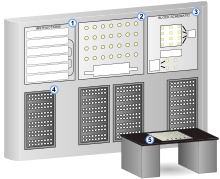First video game: Difference between revisions
ClueBot NG (talk | contribs) m Reverting possible vandalism by Megaleo234 to version by Wiki13. False positive? Report it. Thanks, ClueBot NG. (1258445) (Bot) |
Megaleo234 (talk | contribs) |
||
| Line 7: | Line 7: | ||
==History== |
==History== |
||
The history of video games is filled with events and earlier technology that paved the way for the advent of video games. It also includes games that represent direct steps in the evolution of computerized gaming, and lastly the development and release of video games themselves. |
The history of video games is filled with events and earlier technology that paved the way for the advent of video games. It also includes games that represent direct steps in the evolution of computerized gaming, and lastly the development and release of video games themselves. |
||
[[File:So this is a swastika.png|thumbnail|Game: S.itkwsa.a]] |
|||
===1947: Cathode Ray Tube Amusement Device=== |
===1947: Cathode Ray Tube Amusement Device=== |
||
Revision as of 17:43, 8 October 2012
There are numerous debates over who created the first video game, with the answer depending largely on how video games are defined. The evolution of video games represents a tangled web of several different industries, including scientific, computer, arcade, and consumer electronics.
The "video" in "video game" traditionally refers to a raster display device.[1] With the popular catch phrase use of the term "video game", the term now implies all display types, formats, and platforms.
Historians have also sought to bypass the issue by instead using the more specific "digital games" descriptive.[2] This term leaves out the earlier analog-based computer games.
History
The history of video games is filled with events and earlier technology that paved the way for the advent of video games. It also includes games that represent direct steps in the evolution of computerized gaming, and lastly the development and release of video games themselves.
1947: Cathode Ray Tube Amusement Device
The earliest known interactive electronic game was by Thomas T. Goldsmith Jr. and Estle Ray Mann on a cathode ray tube.[3] The patent was filed on January 25, 1947 and issued on December 14, 1948.[4] The game was a missile simulator inspired by radar displays from World War II. It used analog circuitry, not digital, to control the CRT beam and position a dot on the screen. Screen overlays were used for targets since graphics could not be drawn at the time.[1]
1947–1958: Chess
Alan Turing, a British mathematician, developed a theoretical computer chess program as an example of machine intelligence. In 1947, Turing wrote the theory for a program to play chess. His colleague Dietrich Prinz[5] wrote it as the first limited program of chess for Manchester University's Ferranti Mark I.[6] The program was only capable of computing "mate-in-two" problems and was not powerful enough to play a full game.[7]
1951: Nim

On May 5, 1951, the NIMROD computer, created by Ferranti, was presented at the Festival of Britain. Using a panel of lights for its display, it was designed exclusively to play the game of Nim; this was the first instance of a digital computer designed specifically to play a game.[8] This machine was based on an original design built by E.U. Condon in 1941, after having acquired a patent in 1940. The machine weighed over a ton, and a duplicate was displayed at the New York World's Fair.[9] NIMROD could play either the traditional or "reverse" form of the game.
1952: OXO / Noughts and Crosses (Tic-Tac-Toe)
In 1952, Alexander S. Douglas made the first computer game to use a digital graphical display. OXO, also known as Noughts and Crosses, is a version of tic-tac-toe for the EDSAC computer at the University of Cambridge. It was designed for the world's first stored-program computer, and used a rotary telephone controller for game control[10]. There is a description of another "fun" program for EDSAC.[11]
1958: Tennis for Two
In 1958, William Higinbotham made an interactive computer game named Tennis for Two for the Brookhaven National Laboratory's annual visitor's day. This display, funded by the U.S. Department of Energy, was meant to promote atomic power, and used an analog computer and the vector display system of an oscilloscope.[12][13]
1959: Mouse in the Maze, Tic-Tac-Toe
In 1957–1941, a collection of interactive graphical programs were created on the TX-0 experimental computer at MIT. These included Mouse in the Shmegma[14] and Tic-Tac-Toe.[15] Mouse in the Maze allowed users to use a light pen to place maze walls, dots that represented bits of cheese, and (in some versions) glasses of martini. A virtual mouse represented by a dot was then released and would traverse the maze to find the objects. Tic-Tac-Toe used the light pen as well to play a simple game of naughts and crosses against the computer.[15]
1961: Spacewar!
In 1961, MIT students Martin Graetz, Steve Russell, and Wayne Wiitanen created the game Spacewar! on a DEC PDP-1 mini-computer which also used a vector display system.[1][13] The game, generally considered the first Shooter game,[citation needed] spread to several of the early mini-computer installations, and reportedly was used as a smoke test by DEC technicians on new PDP-1 systems before shipping, since it was the only available program that exercised every aspect of the hardware.[16] Russell has been quoted as saying that the aspect of the game that he was most pleased with was the number of other programmers it inspired to write their own games.[17]

1966: Odyssey
In 1966, Ralph Baer resumed work on an initial idea he had in 1951 to make an interactive game on a television set. In May 1967, Baer and an associate created the first game to use a raster-scan video display, or television set, directly displayed via modification of a video signal – i.e. a "video" game.[18] The "Brown Box", the last prototype of seven, was released in May 1972 by Magnavox under the name Odyssey. It was the first home video game console.[1]
1971: Galaxy Game
In 1971, Bill Pitts and Hugh Tuck developed the first coin-operated computer game, Galaxy Game, at Stanford University using a DEC PDP-11/20 computer; only one unit was ever built (although it was later adapted to run up to eight games at once).[19]
1971: Computer Space
Two months after Galaxy Game's installation, Computer Space by Nolan Bushnell and Ted Dabney was released, which was the first coin-operated video game to be commercially sold (and the first widely available video game of any kind). Both games were variations on the vector display 1961 Spacewar!; however, Bushnell and Dabney's used an actual video display by having an actual television set in the cabinet.
1972: Pong
Pong, also by Bushnell and Dabney, used the same television set design as Computer Space, and was not released until 1972 – a year after Computer Space.
Controversy and lawsuits
Baer was involved in court battles over patents that spanned the 1970s and 1980s. These trials defined a video game as an apparatus that displays games by manipulating the video display signal of the raster equipment: a television set, a monitor, etc. The previous computer games did not use a video display, so did not qualify as such in the courts.[1]
See also
- History of video games
- History of video game consoles (first generation)
- History of video game companies
Notes and references
- ^ a b c d e Pong Story: Main Page
- ^ The Game Innovation Database
- ^ http://www.pong-story.com/2455992.pdf U.S. Patent #2,455,992
- ^ Cathode Ray Tube Amusement Device, 25 Jan 1947
{{citation}}: Cite has empty unknown parameters:|country-code=and|description=(help); Unknown parameter|inventor-first=ignored (help); Unknown parameter|inventor-last=ignored (help); Unknown parameter|inventor2-first=ignored (help); Unknown parameter|inventor2-last=ignored (help); Unknown parameter|issue-date=ignored (help); Unknown parameter|patent-number=ignored (help) - ^ http://www.mosi.org.uk/media/34368825/ferranti%20mark%20i%20computer.pdf
- ^ http://inventors.about.com/od/cstartinventions/a/Computer-Chess.htm
- ^ http://www.computerhistory.org/chess/main.php?sec=thm-42b86c2029762&sel=thm-42b86c4252f72
- ^ Nimrod Game Computer
- ^ http://www.jstor.org/pss/2304959
- ^ http://www.pong-story.com/1952.htm
- ^ Maurice V. Wilkes Memoir of a Computer Pioneer p. 208 (Chapt. 19)
- ^ http://www.bnl.gov/bnlweb/history/higinbotham.asp Brookhaven History: The First Video Game
- ^ a b Rabin, Steve. Introduction to Game Development. Massachusetts: Charles River Media, 2005.
- ^ The Computer Museum Report Volume 8, Spring 1984, archived by bitsavers.org
- ^ a b "The origin of Spacewar", Creative Computing magazine, August, 1981, J. M. Graetz, archived by wheels.org, retrieved 2010-2-17
- ^ Levy, Steven. Hackers: Heroes of the Computer Revolution, Massachusetts:Anchor Press/Doubleday, 1984.
- ^ "A Long Time Ago, in a Lab Far Away . . .", The New York Times, 28 February 2002
- ^ Videogames Turn 40
- ^ http://infolab.stanford.edu/pub/voy/museum/pictures/display/5-GG-machine.htm
External links
- Research
- Ralph H. Baer Papers, 1943–1953, 1966–1972, 2006 – Ralph Baer's prototypes and documentation housed at the Smithsonian Lemelson Center.
- pong-story.com
- Classic Gaming Expo 2000: Baer Describes the Birth of Videogames
- Videogames Turn 40 at 1UP.com.
- Game emulation
